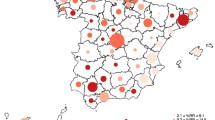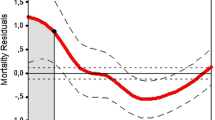Abstract
The impact of short-term temperature fluctuations on mortality has been studied mainly on historical populations, thus providing a limited ability to generalize to contemporary conditions, which would be more useful in determining public health policies aimed at reducing mortality. Therefore, this study examined the effects of monthly temperature fluctuations on mortality in the United States from 1921 to 1985. Monthly data about mortality from the Vital Statistics and temperature from the National Oceanic and Atmospheric Administration and the US Department of Agriculture Weather Bureau were used. Six states were selected to be studied (Massachusetts, Michigan, Washington, Utah, North Carolina, and Mississippi). The analysis was carried out using distributed lag models. The analysis-showed that warmer than usual temperatures in July and August, and unusually cold temperatures from January to June are linked to higher mortality. From September to December unusually low temperatures are associated with higher mortality in most states, while temperature has no significant effect on mortality in June and September. In January and February mortality is especially affected by unusually cold weather in the southern states of Mississippi and North Carolina. For example, a one degreee drop in the mean temperature in 1921 is associated with a more than 3.5% increase in the February crude death rate in Mississippi and North Carolina and a less than 1% increase in the four other states examined. Finally, in the months from January to March the relationship between monthly fluctuations in the crude death rate and temperature declined over time and became relatively weak by 1985.
Similar content being viewed by others
References
Bull GM, Morton J (1975) Relationships of temperature with death rates from all causes and from certain respiratory and artereosclerotic diseases in different age groups. Age Ageing 4:232–246
Bull GM, Morton J (1978) Environment, temperature and death rates. Age Ageing 7:210–224
Clark RP, Edholm OG (1985) Man and his thermal environment. Edward Arnold, London
Climatological Data. The National Oceanic and Atmospheric Administration
Eckstein Z, Schultz TP, Wolpin TP (1985) Short-run fluctuations in fertility and mortality in pre-industrial Sweden. Eur Econ Rev 26:295–317
Ellis FP (1972) Mortality from heat illness and heat-aggravated illness in the United States. Environm Res 5:1–58
Galloway PR (1987) Population, prices, and weather in preindustrial Europe. PhD thesis, University of California at Berkeley
Howe GM (1972) Man, environment and disease in Britain. Barnes and Noble, New York
Keatinge WR, Coleshaw SRK, Cotter F, Mattock M, Murphy M, Chelliah R (1984) Increases in platelet and red cell counts, blood viscosity, and arterial pressure during mild surface cooling: Factors in mortality from coronorary and cerebral thrombosis in winter. Br Med J 289:1405–1408
Knochel JP (1985) Disorders due to heat and cold. In: Wyngaarden JB, Smith LH (eds) Cecil textbook of medicine. Saunders, Philadelphia
Lee R (1981) Short-term variation: Vital rates, prices, and weather In: Wrigley EA, Schofield RS (eds) The population history of England 1541–1871. Harvard University Press, Cambridge pp 356–401
Lerner M, Anderson OW (1963) Health progress in the United States. 1900–1960: A report of health information foundation. University of Chicago Press, Chicago
Lilien DM (1986) Micro TSP, version 5.0
Mortality Statistics. Department of Commerce Bureau of the Census
Pindyck RS, Rubinfeld DL (1981) Econometric models and economic forecasts. McGraw-Hill, New York
Report of the Chief of the Weather Bureau. US Department of Agriculture Weather Bureau
Schryock HS, Siegel JS (1973) The methods and materials of demography US Department of Commerce Bureau of the Census, p 396.
Statistical Abstract of the Unted States. US Department of Commerce Bureau of the Census
Tromp SW (1980) Biometeorology. Heyden, London
Visher SS (1954) Climatic atlas of the United States. Cambridge
Vital Statistic of United States. US Department of Helath, Education and Wellare. Public Health Service
Author information
Authors and Affiliations
Rights and permissions
About this article
Cite this article
Larsen, U. The effects of monthly temperature fluctuations on mortality in the United States from 1921 to 1985. Int J Biometeorol 34, 136–145 (1990). https://doi.org/10.1007/BF01048710
Received:
Revised:
Accepted:
Issue Date:
DOI: https://doi.org/10.1007/BF01048710




